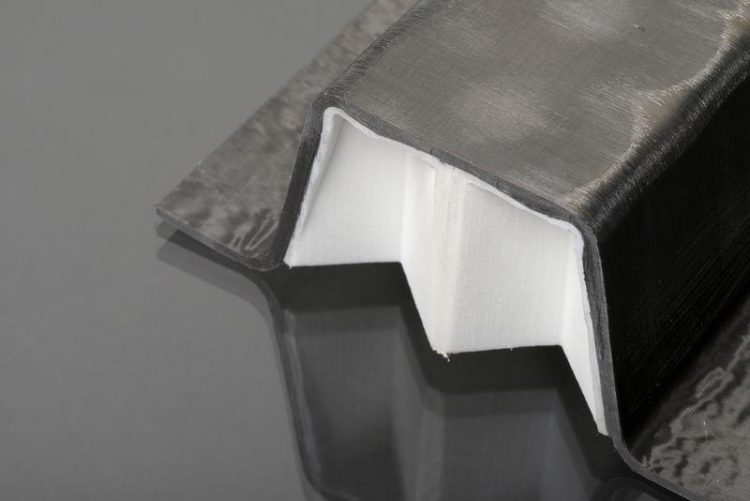3D meets FRP: More flexibility for highly stressed components

The Fraunhofer-Institute for Production Technology IPT in Aachen, in collaboration with its partners within various engineering groups, is currently investigating the combined manufacturing process as part of “LightFlex”, a research project funded by the Federal Ministry of Education and Research (BMBF) in Germany and will be presenting its initial results to the expert visitors to the JEC Trade Fair from 8-10 March in Paris.
Injection molded plastic components which are combined with fiber-composite materials for reinforcement, have one major drawback: it is difficult to adapt them to meet individual wishes or requirements. Since expensive and inflexible injection molding tools are used, only high-volume production is generally affordable.
Special functionalities or modifications made in the product development stage are always associated with costly and time-consuming post-processing steps. Low-volume runs or even prototype manufacture are frequently economically unviable due to the high costs involved.
In such cases, the Fraunhofer IPT and its partners in the “LightFlex” project are therefore planning to replace use of injection molded components with components produced via additive production: 3D-printing permits parts to be customized to meet virtually any requirements and to be provided with the capability to perform any function specified prior to being joined to a thermoplastic fiber composite material in order to achieve the required level of load capacity.
Organic sheets made of unidirectional, semi-finished materials are used in order to optimize the load-bearing capacity of parts used in FRP components. However instead of standard goods with fixed dimensions, near-net-shape organic sheets tailored to suit each individual application are produced using a facility constructed by the Fraunhofer IPT.
This minimizes material waste and results in significant savings in terms of the carbon fibers whose production is associated with high energy consumption. The facility used, had previously been developed by the Fraunhofer IPT as part of the BMBF-funded “E-Profit” project.
The Fraunhofer IPT combines the organic sheets with the 3D-printed structure in a thermoforming process. The 3D-printed part was provided by the project partner Wehl Group Sintertechnik GmbH in Salach.
Overall, the “LightFlex” project encompasses the entire process chain in terms of connected, adaptive production – from the production of semi-finished goods by the Institute for Plastics Processing (IKV) in industry and skilled trades at the RWTH university in Aachen and other partners through to laser trimming by the company Arges GmbH.
The partners will be presenting the production machine as well as a pilot demonstration part produced using the new process combination to visitors to the JEC World international fair for composite materials 2016 in Paris.
Partners in the “LightFlex – Photonic process chain for the flexible, generative, automated and cost-efficient manufacture of customized, hybrid lightweight engineering components from thermoplastic fiber composite plastic” project
– Adam Opel AG, Rüsselsheim
– AFPT GmbH, Dörth
– Arges GmbH, Wackersdorf
– Breyer GmbH Maschinenfabrik, Singen
– F.A. Kümpers GmbH & Co. KG, Rheine
– Fraunhofer-Institut für Produktionstechnologie IPT, Aachen
– Institut für Kunststoffverarbeitung (IKV) in Industrie und Handwerk an der RWTH Aachen
– KUKA Industries, Reis GmbH & Co. KG Maschinenfabrik, Geschäftsbereich Reis Extrusion, Merzenich
– Pixargus GmbH, Würselen
– Wehl Group Sintertechnik GmbH, Salach
This project is funded by the Federal Ministry for Education and Research in Germany (BMBF), reference number 03XP0013. The partners in the project are grateful for this opportunity to thank the BMBF for their support.
http://www.ipt.fraunhofer.de/en/Press/Pressreleases/20160308lightflexjec.html
Media Contact
All latest news from the category: Machine Engineering
Machine engineering is one of Germany’s key industries. The importance of this segment has led to the creation of new university degree programs in fields such as production and logistics, process engineering, vehicle/automotive engineering, production engineering and aerospace engineering among others.
innovations-report offers informative reports and articles covering technologies such as automation, motion, power train, energy, conveyor, plastics, lightweight construction, logistics/warehousing, measurement systems, machine tools and control engineering.
Newest articles

You are What You Eat—Stanford Study Links Fiber to Anti-Cancer Gene Modulation
The Fiber Gap: A Growing Concern in American Diets Fiber is well known to be an important part of a healthy diet, yet less than 10% of Americans eat the minimum recommended…

Trust Your Gut—RNA-Protein Discovery for Better Immunity
HIRI researchers uncover control mechanisms of polysaccharide utilization in Bacteroides thetaiotaomicron. Researchers at the Helmholtz Institute for RNA-based Infection Research (HIRI) and the Julius-Maximilians-Universität (JMU) in Würzburg have identified a…

ASXL1 Mutation: The Hidden Trigger Behind Blood Cancers and Inflammation
Scientists show how a mutated gene harms red and white blood cells. LA JOLLA, CA—Scientists at La Jolla Institute for Immunology (LJI) have discovered how a mutated gene kicks off…



